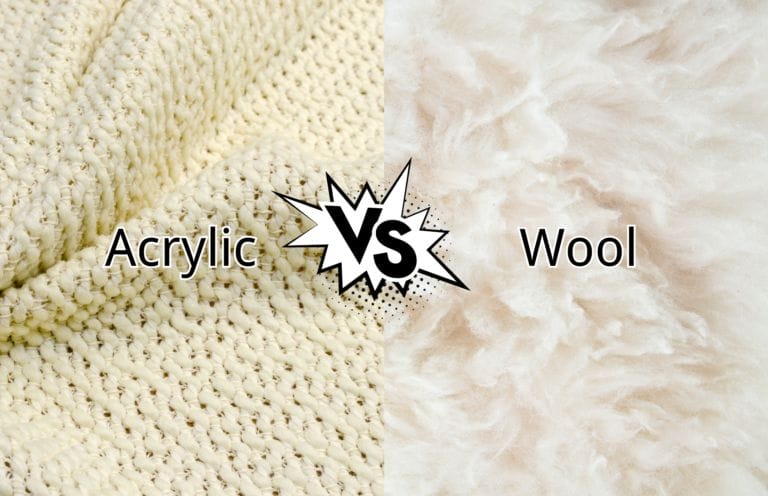Curious about the warmth levels of acrylic and wool? While acrylic is a synthetic fiber known for its lightweight and insulating properties, wool has natural temperature-regulating abilities due to its unique structure. Wool fibers trap air, providing excellent insulation and warmth during chilly seasons. On the other hand, acrylic is less breathable and retains heat well, making it a suitable choice for colder climates. However, wool tends to be warmer overall due to its natural properties.

Understanding the Insulating Properties of Acrylic and Wool
When it comes to warm and cozy clothing options, two popular materials that often come to mind are acrylic and wool. Both of these materials have excellent insulating properties, making them ideal for keeping us warm during chilly weather. In this section, we will explore the insulating properties of acrylic and wool and discuss their advantages and disadvantages.
The Insulating Properties of Acrylic
Acrylic is a synthetic material that is often used as a substitute for wool due to its similar appearance and feel. When it comes to insulation, acrylic fibers have the ability to trap air within their structure, creating a layer of warmth around the body. This trapped air acts as an insulator, preventing heat from escaping and cold air from entering.
One of the key benefits of acrylic as an insulator is its ability to retain heat even when wet. Unlike natural fibers like wool that tend to lose their insulation properties when damp, acrylic fibers continue to provide warmth even in moist conditions. This makes acrylic a great choice for outdoor activities in rainy or snowy environments.
Additionally, acrylic is lightweight and breathable, allowing for easy movement and ventilation. It is also known for its soft and smooth texture, making it comfortable to wear against the skin. Furthermore, acrylic is resistant to shrinking and wrinkling, making it easy to care for and maintain.
The Insulating Properties of Wool
Wool, on the other hand, is a natural fiber that has been used for centuries for its exceptional insulating properties. The structure of wool fibers consists of overlapping scales, which trap air and create an insulating layer. This unique structure allows wool to regulate body temperature by absorbing and releasing moisture, keeping the body warm in cold conditions and cool in hot conditions.
One of the main advantages of wool as an insulator is its ability to provide warmth even when wet. Wool fibers can absorb up to 30% of their weight in moisture without feeling wet, allowing them to continue insulating effectively. This is particularly beneficial in cold and damp environments, where staying dry is crucial for maintaining body heat.
Wool is also naturally flame-resistant, making it a safer choice compared to synthetic materials. It has a high resistance to burning and does not melt or stick to the skin when exposed to heat or flames. This property makes wool a preferred choice for garments such as blankets and winter coats.
Comparing Acrylic and Wool
While both acrylic and wool have excellent insulating properties, there are some key differences between the two materials. Acrylic is generally more affordable and easier to care for compared to wool. It is machine washable and dries quickly, making it a convenient option for everyday wear.
On the other hand, wool is a more luxurious and durable material. It has natural elasticity and resilience, allowing it to withstand repeated wear and maintain its shape over time. Wool garments are known for their longevity and can be passed down through generations if properly cared for.
When it comes to breathability, wool excels in regulating body temperature and moisture. It has superior moisture-wicking properties, pulling sweat away from the body and keeping it dry. Acrylic, while breathable, may not be as effective in moisture management.
In Summary
Both acrylic and wool are reliable choices for insulation, offering warmth and comfort in cold conditions. Acrylic is a synthetic material that retains heat even when wet, is lightweight, and easy to care for. Wool, a natural fiber, provides excellent insulation even when damp, regulates body temperature, and is highly durable. The choice between acrylic and wool ultimately depends on personal preference, budget, and specific requirements.

The Science Behind the Heat Retention of Acrylic and Wool
When it comes to staying warm and cozy during the winter months, the choice of fabric can make a significant difference. Acrylic and wool are two popular materials known for their excellent heat retention properties. In this section, we will explore the science behind why these fabrics are so effective at keeping us warm.
The Insulating Properties of Acrylic
Acrylic is a synthetic fiber that is widely used in the production of winter garments. One of the main reasons why acrylic is known for its heat retention capabilities is its insulating properties.
Acrylic fibers have a high bulkiness, meaning they are capable of trapping air within their structure. Air is a poor conductor of heat, which means it can effectively prevent heat loss from the body to the surrounding environment. As a result, acrylic fabrics create a layer of insulation that helps to retain body heat and keeps us warm even in cold temperatures.
Furthermore, acrylic fibers have a low moisture absorption rate. Moisture can conduct heat away from the body, making us feel colder. By repelling moisture, acrylic fabrics ensure that the body’s natural warmth is preserved, providing a comfortable and warm wearing experience.
The Natural Warmth of Wool
Wool, on the other hand, is a natural fiber that has been used for centuries for its exceptional heat retention properties. The unique structure of wool fibers contributes to their ability to retain heat.
Wool fibers are composed of an inner core, known as the medulla, and an outer layer, known as the cortex. The medulla is responsible for trapping air, while the cortex provides strength and durability to the fiber. This combination of air pockets and strong fibers helps to create a natural insulation system within wool garments.
Similar to acrylic, wool has a low thermal conductivity. This means that it is a poor conductor of heat, allowing it to trap warmth close to the body. Additionally, wool can absorb and retain moisture without feeling wet, keeping the body dry and warm even in damp conditions.
Comparing Acrylic and Wool
While both acrylic and wool are known for their heat retention properties, there are some differences between the two fabrics.
| Acrylic | Wool |
|---|---|
| High bulkiness for trapping air | Natural insulation system with air pockets |
| Low moisture absorption | Can absorb and retain moisture without feeling wet |
| Lightweight and soft | Durable and resilient |
| Less expensive | Generally more expensive |
Choosing between acrylic and wool depends on individual preferences and needs. Acrylic is often favored for its affordability, lightweight feel, and low maintenance requirements. On the other hand, wool is highly regarded for its natural warmth, moisture-wicking abilities, and durability.
In summary, both acrylic and wool are excellent choices for staying warm in cold weather. Their unique properties, such as insulation and moisture management, contribute to their exceptional heat retention capabilities. Whether you opt for acrylic or wool, you can enjoy a cozy and comfortable winter season.

Benefits of Acrylic for Warmth: Durability and Moisture Resistance
Acrylic is a versatile and popular material that offers numerous benefits, especially when it comes to providing warmth. Whether you are looking for cozy winter garments or comfortable home accessories, acrylic proves to be an excellent choice due to its durability and moisture resistance.
Durability
One of the key advantages of acrylic when it comes to warmth is its durability. Acrylic fibers are known for their strength and resilience, making them highly resistant to wear and tear. This means that garments and accessories made from acrylic can withstand everyday use and maintain their insulating properties over time.
Unlike natural fibers such as wool, acrylic does not shrink or lose its shape when exposed to moisture or washing. This makes it an ideal choice for items that require frequent cleaning, as it will not deform or become misshapen. The durability of acrylic fibers ensures that your warm clothing and accessories will last for many seasons, providing long-lasting comfort and protection against cold weather.
Moisture Resistance
Another significant benefit of acrylic for warmth is its moisture resistance. Acrylic fibers have a low absorbency rate, meaning they do not easily retain moisture. This is particularly advantageous during the winter months when staying dry is essential for maintaining body heat.
When exposed to moisture, acrylic fibers effectively wick away sweat and moisture from the skin, keeping you dry and comfortable. This moisture resistance also helps to prevent the growth of bacteria and fungi, ensuring that your acrylic garments and accessories remain hygienic and odor-free.
The moisture resistance of acrylic is especially beneficial for outdoor activities in cold and wet conditions. Whether you are skiing, hiking, or simply taking a walk on a rainy day, acrylic materials will help keep you warm and dry throughout your adventures.
Additional Benefits
Aside from its durability and moisture resistance, acrylic offers several other benefits for warmth. It is lightweight and has excellent heat retention properties, making it a great choice for layering under other clothing items. Acrylic also dries quickly, allowing you to wash and wear your favorite acrylic garments or accessories in no time.
Furthermore, acrylic is a cost-effective alternative to natural fibers such as wool or cashmere. It offers similar levels of warmth and comfort without the higher price tag. This affordability makes acrylic an accessible option for individuals seeking warmth without compromising on quality.
Summary
Acrylic is a fantastic choice for warmth due to its durability and moisture resistance. Its strong and resilient fibers ensure that garments and accessories made from acrylic can withstand everyday use, while its low absorbency rate keeps you dry and comfortable. In addition to these benefits, acrylic is lightweight, quick-drying, and cost-effective. When it comes to staying warm in colder temperatures, acrylic proves to be a reliable and practical option.
Advantages of Wool as a Warmth-Providing Material: Natural Fibers and Breathability
When it comes to staying warm during colder months, choosing the right material for your clothing is essential. One of the best options available is wool, known for its exceptional warmth-providing properties. In this section, we will explore the advantages of wool as a warmth-providing material, focusing on its natural fibers and breathability.
Natural Fibers
Wool is made from the fibers of animal hair, typically sourced from sheep. These natural fibers have unique properties that make wool an excellent choice for warmth. One of the key advantages of natural fibers is their ability to trap air. The crimped structure of wool fibers creates tiny pockets of air, which act as insulation and help retain heat close to the body.
Additionally, wool fibers have a natural waxy coating called lanolin. Lanolin provides an added layer of protection against the elements by making wool resistant to water. This means that even if wool gets wet, it can still provide warmth, unlike many synthetic materials.
Breathability
Contrary to popular belief, wool is a breathable material. It has the unique ability to regulate body temperature, keeping you warm in cold conditions and cool in warmer weather. This is due to wool’s natural moisture-wicking properties.
Wool fibers can absorb moisture vapor from your skin and release it into the air, keeping you dry and comfortable. This process helps prevent overheating and excessive sweating, making wool an ideal choice for outdoor activities or layering under heavier clothing.
In addition to moisture-wicking, wool is also naturally odor-resistant. The fibers have antimicrobial properties that inhibit the growth of bacteria, reducing the chances of unpleasant odors even after prolonged use.
Other Advantages
Aside from its warmth-providing properties, wool offers several other advantages:
- Durability: Wool is known for its strength and resilience, making it a long-lasting material that can withstand wear and tear.
- Fire Resistance: Wool is naturally flame retardant, making it a safer option compared to synthetic materials that can melt or catch fire easily.
- Environmental Sustainability: Wool is a renewable resource, as sheep can be shorn multiple times throughout their lives. It is also biodegradable, making it an eco-friendly choice.
- Versatility: Wool can be woven into various weights and textures, making it suitable for a wide range of clothing and accessory options.
In summary, wool is an excellent warmth-providing material due to its natural fibers and breathability. The unique properties of wool fibers, such as their ability to trap air and regulate body temperature, make it an ideal choice for cold weather conditions. Additionally, wool offers durability, fire resistance, environmental sustainability, and versatility, making it a practical and eco-friendly option for warmth and comfort.
FAQs
Is acrylic warmer than wool?
No, wool is generally warmer than acrylic. Wool is a natural fiber that has excellent insulating properties and can retain heat even when wet. Acrylic is a synthetic fiber that does not provide the same level of insulation as wool.
Conclusion:
In conclusion, when it comes to warmth, wool still remains the superior choice compared to acrylic. The natural insulation properties of wool make it highly effective in retaining heat, keeping you cozy and warm in colder temperatures. While acrylic may provide some level of warmth, it cannot match the insulating qualities of wool. Additionally, wool has the ability to regulate body temperature by wicking away moisture, while acrylic may trap moisture and cause discomfort. So, when it comes to staying warm and comfortable, opt for wool to experience the ultimate coziness during the chilly seasons.
